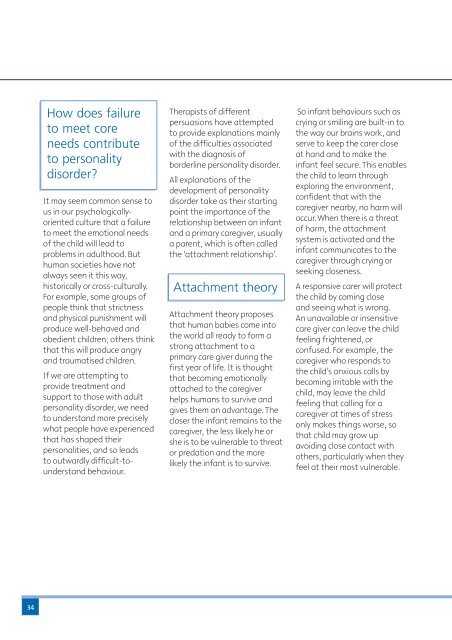Meeting-The-Challenge-Making-a-Difference-Practitioner-Guide
Meeting-The-Challenge-Making-a-Difference-Practitioner-Guide
Meeting-The-Challenge-Making-a-Difference-Practitioner-Guide
Create successful ePaper yourself
Turn your PDF publications into a flip-book with our unique Google optimized e-Paper software.
How does failure<br />
to meet core<br />
needs contribute<br />
to personality<br />
disorder?<br />
It may seem common sense to<br />
us in our psychologicallyoriented<br />
culture that a failure<br />
to meet the emotional needs<br />
of the child will lead to<br />
problems in adulthood. But<br />
human societies have not<br />
always seen it this way,<br />
historically or cross-culturally.<br />
For example, some groups of<br />
people think that strictness<br />
and physical punishment will<br />
produce well-behaved and<br />
obedient children; others think<br />
that this will produce angry<br />
and traumatised children.<br />
If we are attempting to<br />
provide treatment and<br />
support to those with adult<br />
personality disorder, we need<br />
to understand more precisely<br />
what people have experienced<br />
that has shaped their<br />
personalities, and so leads<br />
to outwardly difficult-tounderstand<br />
behaviour.<br />
<strong>The</strong>rapists of different<br />
persuasions have attempted<br />
to provide explanations mainly<br />
of the difficulties associated<br />
with the diagnosis of<br />
borderline personality disorder.<br />
All explanations of the<br />
development of personality<br />
disorder take as their starting<br />
point the importance of the<br />
relationship between an infant<br />
and a primary caregiver, usually<br />
a parent, which is often called<br />
the ‘attachment relationship’.<br />
Attachment theory<br />
Attachment theory proposes<br />
that human babies come into<br />
the world all ready to form a<br />
strong attachment to a<br />
primary care giver during the<br />
first year of life. It is thought<br />
that becoming emotionally<br />
attached to the caregiver<br />
helps humans to survive and<br />
gives them an advantage. <strong>The</strong><br />
closer the infant remains to the<br />
caregiver, the less likely he or<br />
she is to be vulnerable to threat<br />
or predation and the more<br />
likely the infant is to survive.<br />
So infant behaviours such as<br />
crying or smiling are built-in to<br />
the way our brains work, and<br />
serve to keep the carer close<br />
at hand and to make the<br />
infant feel secure. This enables<br />
the child to learn through<br />
exploring the environment,<br />
confident that with the<br />
caregiver nearby, no harm will<br />
occur. When there is a threat<br />
of harm, the attachment<br />
system is activated and the<br />
infant communicates to the<br />
caregiver through crying or<br />
seeking closeness.<br />
A responsive carer will protect<br />
the child by coming close<br />
and seeing what is wrong.<br />
An unavailable or insensitive<br />
care giver can leave the child<br />
feeling frightened, or<br />
confused. For example, the<br />
caregiver who responds to<br />
the child’s anxious calls by<br />
becoming irritable with the<br />
child, may leave the child<br />
feeling that calling for a<br />
caregiver at times of stress<br />
only makes things worse, so<br />
that child may grow up<br />
avoiding close contact with<br />
others, particularly when they<br />
feel at their most vulnerable.<br />
34


